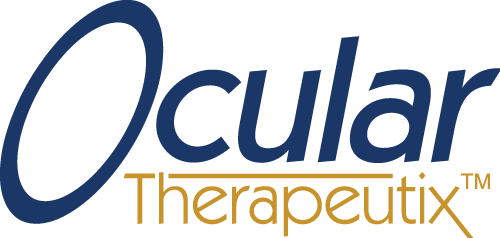UNITED STATES
SECURITIES AND EXCHANGE COMMISSION
WASHINGTON, D.C. 20549
FORM 8-K
CURRENT REPORT
Pursuant to Section 13 or 15(d)
of the Securities Exchange Act of 1934
Date of Report (Date of earliest event reported): June 21, 2019
OCULAR THERAPEUTIX, INC.
(Exact Name of Company as Specified in Charter)
|
Delaware |
|
001-36554 |
|
20-5560161 |
|
(State or Other Jurisdiction |
|
(Commission |
|
(IRS Employer |
15 Crosby Drive
Bedford, MA 01730
(Address of Principal Executive Offices) (Zip Code)
Company’s telephone number, including area code: (781) 357-4000
Check the appropriate box below if the Form 8-K filing is intended to simultaneously satisfy the filing obligation of the registrant under any of the following provisions (see General Instruction A.2. below):
o Written communications pursuant to Rule 425 under the Securities Act (17 CFR 230.425)
o Soliciting material pursuant to Rule 14a-12 under the Exchange Act (17 CFR 240.14a-12)
o Pre-commencement communications pursuant to Rule 14d-2(b) under the Exchange Act (17 CFR 240.14d-2(b))
o Pre-commencement communications pursuant to Rule 13e-4(c) under the Exchange Act (17 CFR 240.13e-4(c))
Securities registered pursuant to Section 12(b) of the Act:
|
Title of each class |
|
Trading Symbol(s) |
|
Name of exchange on which registered |
|
Common Stock, $0.0001 par value per share |
|
OCUL |
|
The Nasdaq Global Select Market |
Indicate by check mark whether the registrant is an emerging growth company as defined in Rule 405 of the Securities Act of 1933 (§230.405 of this chapter) or Rule 12b-2 of the Securities Exchange Act of 1934 (§240.12b-2 of this chapter).
Emerging growth company x
If an emerging growth company, indicate by check mark if the registrant has elected not to use the extended transition period for complying with any new or revised financial accounting standards provided pursuant to Section 13(a) of the Exchange Act. x
Item 8.01. Other Events.
On June 21, 2019, Ocular Therapeutix, Inc. announced the U.S. Food and Drug Administration (the “FDA”) approved a Supplemental New Drug Application (the “sNDA”) for DEXTENZA to include the treatment of ocular inflammation following ophthalmic surgery as an additional indication. With the approval of the sNDA, DEXTENZA is now approved for the treatment of both ocular inflammation and pain following ophthalmic surgery.
DEXTENZA is the first FDA-approved intracanalicular insert, a novel route of administration that delivers drug to the surface of the eye without the need for eye drops. DEXTENZA is a preservative-free, resorbable hydrogel insert that delivers 0.4mg of dexamethasone to treat post-surgical ocular inflammation and pain for up to 30 days with a single administration. DEXTENZA originally received FDA approval in November 2018 for the treatment of ocular pain following ophthalmic surgery.
About DEXTENZA® (dexamethasone ophthalmic insert) 0.4mg
DEXTENZA is a corticosteroid indicated for the treatment of ocular pain following ophthalmic surgery. DEXTENZA is inserted into the lower lacrimal punctum into the canaliculus by the physician following ophthalmic surgery. A single DEXTENZA releases a 0.4mg dose of dexamethasone for up to 30 days following insertion. DEXTENZA is preservative free, resorbable and does not require removal. Saline irrigation or manual expression can be performed to remove the insert, if necessary.
DEXTENZA is contraindicated in patients with active corneal, conjunctival or canalicular infections, including epithelial herpes simplex keratitis (dendritic keratitis), vaccinia, and varicella; mycobacterial infections; fungal diseases of the eye; and dacryocystitis. Prolonged use of corticosteroids may result in glaucoma with damage to the optic nerve, defects in visual acuity and fields of vision. Steroids should be used with caution in the presence of glaucoma. Intraocular pressure should be monitored during the course of the treatment. Corticosteroids may suppress the host response to, and increase the hazard for and severity of, secondary bacterial, viral, or fungal infections. The use of steroids after cataract surgery may delay wound healing and increase the incidence of bleb formation.
Safety was assessed from the three Phase 3 clinical trials and a Phase 2 clinical trial. Overall, 567 subjects were exposed to DEXTENZA. The most common ocular adverse reactions in subjects treated with DEXTENZA were: anterior chamber inflammation including iritis and iridocyclitis (10%), increased intraocular pressure (6%), reduced visual acuity (2%), cystoid macular edema (1%), corneal edema (1%), eye pain (1%), and conjunctival hyperemia (1%). The most common non-ocular adverse event was headache (1%).
SIGNATURES
Pursuant to the requirements of the Securities Exchange Act of 1934, the registrant has duly caused this report to be signed on its behalf by the undersigned hereunto duly authorized.
|
|
OCULAR THERAPEUTIX, INC. | |
|
|
|
|
|
Date: June 21, 2019 |
By: |
/s/ Donald Notman |
|
|
|
Donald Notman |
|
|
|
Chief Financial Officer |
